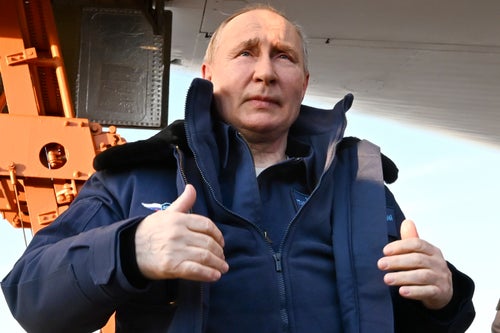

Separatists in Moldova have formally asked Vladimir Putin to “protect” them against “pressure” coming from their central government.
Moldova, a country on the western side of Ukraine, is pretty far away from Russia itself – but pro-Russia rebels in the breakaway region of Transnistria want Putin’s support right now.
The separatists did stop short of officially asking to become part of Russia, though, despite early reports suggesting Transnistria would request an annexation.
Here’s what you need to know.
Why did some think Transnistria wanted to become part of Russia?
A Transnistrian opposition politician, Gennady Chorba, warned last week that the pro-separatist government might be making a request to the Kremlin on Wednesday, when its Congress of Deputies meets.
This is a noteworthy meeting – the last time it gathered was in 2006, when the region passed a referendum trying to join Russia and rejected a separate referendum on reuniting with Moldova.
According to the US-based think tank the Institute for the Study of War (ISW), the politicians might have been thinking of asking Russia to annexe Transnistria under the pretext of needing to “protect Russian citizens and compatriots”, supposedly from threats originating from “Moldova or Nato or both.”
Chorba’s remarks also come after Russia’s foreign minister, Sergei Lavrov, warned the rights of pro-Russia separatists in Transnistria need to be respected.
Lavrov even accused the West of making Moldova “the next Ukraine” in February last year – a worrying comparison after Russia’s brutal invasion of Ukraine.
What actually happened instead?
A resolution adopted on Wednesday by hundreds of politicians in the region read: ”“[We resolved to] appeal to the Federation Council and the State Duma of the Russian Federation, requesting measures to protect Transnistria amidst increased pressure from Moldova.”
Moldova has denied pressuring the region at all, instead claiming Russia destabilised the area.
What is the connection between Transnistria and Russia?
A former Soviet state, Transnistria has a population of around 400,000 where Russian is widely spoken.
In fact, more than 220,000 Russian citizens live in the region, according to the separatist politicians.
It illegally declared independence in 1990 but it is still tied economically to Moldova – no UN member recognises its sovereignty and it’s widely perceived as part of Moldova.
But, Transnistria gets free gas and pensions from Russia, which also watches over its security.
Meanwhile, the rest of Moldova has ambitions to join the EU – an expansion Putin has been trying to fight against for some time, and which partly motivates the Russian president’s invasion of Ukraine.
“The Kremlin seeks to use Transnistria as a Russian-controlled proxy that it can use to derail Moldova’s EU accession process, among other things,” the analysts at ISW explained.
“The Kremlin has geopolitical ambitions to control all post-Soviet states, including Moldova, and considers Moldova to be a part of Russia’s rightful historical territory.”
The region is in an advantageous position for Moscow, too, being on the western border to Ukraine – according to Reuters, 2,000 Russian “peacekeepers” stay on the border between the two areas.
Was it ever likely Putin would annexe the region?
The probability of it actually happening was always pretty low.
The ISW’s analysts said “in the most dangerous course of action”, Putin could declare Russia’s annexation of the region during his planned address to the Russian Federal Assembly on Thursday, February 29 if Transnistria requested.
But, they added: “That appears unlikely.”
According to the ISW, Putin may be trying to stoke tensions in the separatist region to create an “imminent political crisis” in Moldova.
Moldova’s central government already admitted a month ago talks with the separatist region about joining the EU were “difficult”, while the Transnistrian government said the situation had “deteriorated sharply since January 1, 2024” – which is why its congress meeting was hastily arranged.
The region could offer a geopolitical advantage to Putin in the Ukraine war, too.
Back in 2022, there were fears Moscow might use the breakaway region to form another front in the attack on Ukraine.
Putin has used separatists to his advantage before – he recognised the independence of two breakaway Ukrainian regions, Luhansk People’s Republic and Donetsk’s People’s Republic – to justify his invasion of Ukraine back in February 2022.
He ordered troops into the European country three days after declaring the two pro-Russia regions as republics, claiming Russia was just trying to protect them.
However, as ISW predicted: “Putin will more likely welcome whatever action the Transnistrian Congress of Deputies takes and offer observations on the situation.”
Analysts in the Moldovan capital Chisinau had a similar take – that it was unlikely to actually happen.
As one anonymous source telling The Telegraph: “Somebody may have ordered this to provoke tensions, to provoke reactions, and it’s worked.”